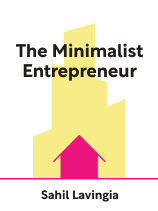

This article is an excerpt from the Shortform book guide to "The Minimalist Entrepreneur" by Sahil Lavingia. Shortform has the world's best summaries and analyses of books you should be reading.
Like this article? Sign up for a free trial here.
What type of business are you in? What is the key to identifying your potential market?
In The Minimalist Entrepreneur, Sahil Lavingia says the first step in building a minimalist business is identifying the right business for you. To do this, you need to find your niche and establish yourself within the community.
Let’s look at how to identify your potential market.
Identify Your Business
Lavingia stresses that it’s crucial to invest significant time and effort in this first step because this business will be your life and livelihood. Remember, you’re not looking to build a fast-growing company that you can turn around and sell to get rich quick. You’re building your life’s work. (Shortform note: Research has shown that despite often working longer hours and living with financial uncertainty, self-employed people are happier. They enjoy having autonomy and freedom to innovate, and they’re more engaged in their work.)
Before you dive into an exploration of how to identify your potential market, Lavingia advises you to keep a few things in mind to learn:
- Don’t take venture capital. This makes you indebted to, and dependent on, the investors, and they’ll always want to emphasize fast growth. Venture capital is high-risk and high-return—and has a high rate of failure. Remind yourself that you don’t need a billion dollars. You just need a sustainable profit. (Shortform note: Whether you decide to seek venture capital or not may depend on what you prioritize. Do you prefer to keep firm control over your business, or would you rather give up some of that control for the guidance and connections a venture capital firm can provide you?)
- Don’t quit your day job and invest everything into this just yet. Start your business in your spare time as a side project. It will take time and you need income while you’re working on it. (Shortform note: One of the potential disadvantages to starting a business in your spare time is that you may continue to see it as a hobby rather than your career. Keeping the “safety net” of your day job could weaken the motivation and drive you might have if your business was your sole source of income.)
- Think of yourself as a creator, not a business person. You’re an innovative source of ideas, working on something you care about. This will help overcome some of the mental barriers of thinking you don’t know enough about “business.” The business is just the vehicle by which you’re making your creation available to the world. You don’t have to learn how to do everything first. You need to just start, and then learn as you go.
- Start small and slow. This will allow you to try out different approaches and change directions when you need to. You may have to try a few different things to find the right path, but you will eventually find it.
Keeping all of this in mind, let’s explore Lavingia’s method for identifying your potential market. We’ll talk about how to find your niche within the communities you belong to, how to establish yourself as a creator in those communities, and how to get feedback you can implement to solidify your business idea.
1. Find Your Niche
Identifying your business starts with asking what problem you want to solve, and for what community of people. Lavingia says this often starts with trying to solve a problem you have. So, for example, he got ideas for new apps by noticing things he wished there was an app for. His current business, Gumroad, was born similarly. He needed a platform for selling icons he had designed, so he created it.
Unlike other business models, in Lavingia’s minimalist method you are not “creating” a problem people didn’t know they had and then selling them the solution (for example, a beauty product designed to hide your pores when you never thought about your pores before). You’re identifying a problem that already exists within a community you care about, and that you want to solve for those people.
So, to start getting ideas, you need to first identify your potential target communities. Lavingia says many businesses fail because they don’t start with a target community in mind.
To narrow down who your customer is and what problem you are trying to solve for them, look in your own communities. Lavingia says this will ensure that you’ll have a business you’ll be passionate about. Think about any hobbies, interests, or social groups you belong to, online or in your local community, and write down the answers to these questions:
- What kinds of people do you enjoy spending time with, or regularly interact with due to a common interest?
- What kinds of people like to hear what you have to say?
- Where can you find these people?
Once you have solid answers, find as many relevant groups as you can (online and in person), and join them, in order to get to know people and the subject better. Lavingia advises looking for Facebook groups, Reddit communities, and related Twitter and Instagram hashtags to find people involved in your target groups and where they’re gathering.
Lavingia says you shouldn’t think of this as “networking,” but as simply joining communities. With networking, you’d be starting from scratch trying to form connections with people who might be able to help you. Whereas within your communities you already have a natural connection, and your relationships are reciprocal.
2. Establish Yourself
Once you’ve joined all the groups you can find, you’ll want to start building strong relationships within these communities to identify your potential market. In most social media communities, Lavingia explains, the vast majority of members are just passive observers, or “lurkers.” A smaller group is active contributors, meaning they regularly participate in discussions. And an even smaller group are creators, meaning they actually create and post content for others to comment on. You’ll likely find a similar structure with in-person community groups.
Lavingia says you should gradually work your way up to being a recognized expert in your communities, in this way:
- Lurk for a while. Read or observe to learn everything you can about the group and the topics being discussed.
- Start to contribute. When you’ve familiarized yourself with the group and content, start engaging in discussions. As you do this more frequently, people in your communities will eventually start to recognize you. If you consistently keep learning, you’ll increasingly have valuable contributions.
- Start to create. When you’re comfortable and confident with the subject matter, start to create and teach. Whatever you’ve learned, there will be others who want to learn it. Create your own posts, for example, and others will begin to see you as an established expert in the community.
- Discover what excites you. As you get more involved with these groups, evaluate where you really feel excited, and determine whether a particular community or niche within that community is aligning with your passion.
- Listen to people. As you have conversations with people, really listen to them. They’ll eventually tell you what problem needs solving. Your business will be solving it for them.
Lavingia says you can try this method with a few different communities/interests until you find the right community with the right problem. Then it will be time to pin down the solution to the problem.
3. Experiment and Adjust
When you’ve determined your community and its problem, you’ll next want to do what Lavingia calls “processizing,” which is essentially a process of experimentation to identify your potential market. This means you’ll try things out and get feedback, adjust accordingly, and try something else. He offers some advice for a few possible avenues to turning your problem into a monetizable solution. You could:
- Sell your knowledge in classes, workshops, podcasts, video tutorials, or books.
- Sell a physical product you’ve designed and/or made.
- Offer a service people need.
- Create a way to connect people (for example, a social media app).
- Create software solutions.
Lavingia suggests you start out by offering your product or service to your community on a freelance basis or as a side project, to see what people are willing to pay for (and how much they’re willing to pay). So, for example, you might offer a workshop to your community and see who signs up. If it doesn’t go well, try a different topic or format. If you want to provide a service—for example, graphic design—start offering it as a side job, and see what kinds of projects people request most often. Be patient, because this process can take years to develop into a successful business.
Lavingia also suggests you reach out to family and friends during this phase. Offer them a trial or sample of your product or service (or sign them on as paying customers if they’re willing) and ask them for honest feedback. He says you can also ask your circle of acquaintances how much they think they’d pay for your product to get your pricing nailed down. A few bits of advice Lavingia offers for pricing are:
- Don’t undervalue your product.
- Factor in the costs you have and then how much profit you’ll need to add to the price.
- Think about making tiered prices, for different levels of service or product features (this is especially common with software businesses).
- Remember pricing is not permanent. You can always adjust it later. You may want to start lower and then go up as your products/services improve.
As you experiment and receive feedback, Lavingia emphasizes that you should take copious notes on what works and what doesn’t. Use this information to recalibrate, and keep trying. He says you may need to experiment with a number of directions and price points before settling on what works. Don’t get discouraged; just keep trying. Eventually, he says, you will have found your niche and be ready to launch your business.

———End of Preview———
Like what you just read? Read the rest of the world's best book summary and analysis of Sahil Lavingia's "The Minimalist Entrepreneur" at Shortform.
Here's what you'll find in our full The Minimalist Entrepreneur summary:
- Detailed advice for starting your own business without venture capital
- How to run your business sustainably and contribute to the world
- Why you don’t need to spend any money on marketing






